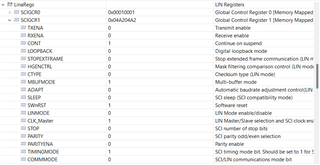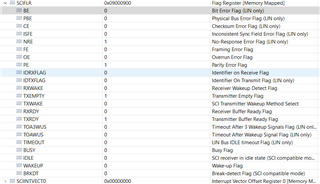主题中讨论的其他器件: C2000WARE
大家好、
我对 TMS320F280025c 微控制器非常陌生。 在我的项目中、我希望在 SCI 模式下使用具有 DMA 的 LIN 通信、并希望查看 Putty 终端中的数据字节。
我在"C2000Ware_4_02_00_00\driverlib\f28002x\examples\lin\line_ex3_sci_dma.c"示例代码中找到的程序
我发现 GPIO_22和 GPIO_23引脚分别用于 LIN_TX 和 LIN_Rx。 因此、我配置这些引脚并禁用内部回送模式。 为了进行传输、我只发送了两个字节的字符数据并进行了一些修改。 在示波器中、我观察到在 DMA 传输请求后、通过 GPIO_22引脚触发了单个脉冲、但未找到任何数据位或其他脉冲。
我随函附上经修改的代码。 你的帮助将减轻我的负担。 请帮帮我。
//############################################################################# // // FILE: lin_ex3_sci_dma.c // // TITLE: LIN SCI MODE Internal Loopback with DMA // //! \addtogroup driver_example_list //! <h1> LIN SCI MODE Internal Loopback with DMA </h1> //! //! This example configures the LIN module in SCI mode for internal loopback //! with the use of the DMA. The LIN module performs as SCI with a set //! character and frame length in multi-buffer mode. When the transmit buffers //! in the LINTD0 and LINTD1 registers have enough space, the DMA will transfer //! data from global variable sData into those transmit registers. Once the //! received buffers in the LINRD0 and LINRD1 registers contain data,the DMA //! will transfer the data into the global variable rdata. //! //! When all data has been placed into rData, a check of the validity of the //! data will be performed in one of the DMA channels' ISRs. //! //! \b External \b Connections \n //! - None //! //! \b Watch \b Variables \n //! - \b sData - Data to send //! - \b rData - Received data //! // //############################################################################# // // // $Copyright: // Copyright (C) 2022 Texas Instruments Incorporated - http://www.ti.com/ // // Redistribution and use in source and binary forms, with or without // modification, are permitted provided that the following conditions // are met: // // Redistributions of source code must retain the above copyright // notice, this list of conditions and the following disclaimer. // // Redistributions in binary form must reproduce the above copyright // notice, this list of conditions and the following disclaimer in the // documentation and/or other materials provided with the // distribution. // // Neither the name of Texas Instruments Incorporated nor the names of // its contributors may be used to endorse or promote products derived // from this software without specific prior written permission. // // THIS SOFTWARE IS PROVIDED BY THE COPYRIGHT HOLDERS AND CONTRIBUTORS // "AS IS" AND ANY EXPRESS OR IMPLIED WARRANTIES, INCLUDING, BUT NOT // LIMITED TO, THE IMPLIED WARRANTIES OF MERCHANTABILITY AND FITNESS FOR // A PARTICULAR PURPOSE ARE DISCLAIMED. IN NO EVENT SHALL THE COPYRIGHT // OWNER OR CONTRIBUTORS BE LIABLE FOR ANY DIRECT, INDIRECT, INCIDENTAL, // SPECIAL, EXEMPLARY, OR CONSEQUENTIAL DAMAGES (INCLUDING, BUT NOT // LIMITED TO, PROCUREMENT OF SUBSTITUTE GOODS OR SERVICES; LOSS OF USE, // DATA, OR PROFITS; OR BUSINESS INTERRUPTION) HOWEVER CAUSED AND ON ANY // THEORY OF LIABILITY, WHETHER IN CONTRACT, STRICT LIABILITY, OR TORT // (INCLUDING NEGLIGENCE OR OTHERWISE) ARISING IN ANY WAY OUT OF THE USE // OF THIS SOFTWARE, EVEN IF ADVISED OF THE POSSIBILITY OF SUCH DAMAGE. // $ //############################################################################# // // Included Files // #include "driverlib.h" #include "device.h" // // Defines // //Modified // #define BURST 4 // #define TRANSFER 32 // #define CHAR_LENGTH 8 // #define FRAME_LENGTH 8 #define BURST 1 #define TRANSFER 1 #define CHAR_LENGTH 8 #define FRAME_LENGTH 1 // // Configure the Baud Rate to 115.207kHz // uint32_t PRESCALER=0x000001a; uint16_t DIVIDER=0x0002; // // Globals // //Modified uint16_t sData[2] = {'a', 'b'}; uint16_t rData[2]; // unsigned char *sData; // unsigned char *rData; //Place buffers in GSRAM #pragma DATA_SECTION(sData, "ramgs0"); #pragma DATA_SECTION(rData, "ramgs0"); volatile uint16_t done = 0; // Flag to set when all data transfered // // Function Prototypes // void initDMA(void); void configureSCIMode(void); __interrupt void dmaCh5ISR(void); __interrupt void dmaCh6ISR(void); // // Main // void main(void) { // // Initialize device clock and peripherals // Device_init(); // // Initialize GPIO // Device_initGPIO(); // Pin config for LIN tx and LIN rx GPIO_setPinConfig(DEVICE_GPIO_CFG_LINTXA); GPIO_setPinConfig(DEVICE_GPIO_CFG_LINRXA); // GPIO_23 is used as LINTXA GPIO_setDirectionMode(23, GPIO_DIR_MODE_IN); GPIO_setPadConfig(23, GPIO_PIN_TYPE_PULLUP); GPIO_setQualificationMode(23, GPIO_QUAL_ASYNC); // GPIO_23 is used as LINRXA GPIO_setDirectionMode(22, GPIO_DIR_MODE_OUT); GPIO_setPadConfig(22, GPIO_PIN_TYPE_STD); GPIO_setQualificationMode(22, GPIO_QUAL_ASYNC); // // Initialize PIE and clear PIE registers. Disables CPU interrupts. // Interrupt_initModule(); // // Initialize the PIE vector table with pointers to the shell Interrupt // Service Routines (ISR). // Interrupt_initVectorTable(); EINT; ERTM; // // Interrupts that are used in this example are re-mapped to // ISR functions found within this file. // This registers the interrupt handler in PIE vector table. // Interrupt_register(INT_DMA_CH5, &dmaCh5ISR); Interrupt_register(INT_DMA_CH6, &dmaCh6ISR); // // Enable the DMA interrupt signals // Interrupt_enable(INT_DMA_CH5); Interrupt_enable(INT_DMA_CH6); // // Initialize the DMA // initDMA(); // //Initialize the LIN Module // LIN_initModule(LINA_BASE); // // Configure the LIN module to operate in SCI mode // configureSCIMode(); // // Initialize the data buffers // //Modified // for(i = 0; i < 128; i++) // { // sData[i]= i; // rData[i]= 0; // } // // Wait for the SCI receiver to be idle // while(!LIN_isSCIReceiverIdle(LINA_BASE)); // // Wait until space is available in the transmit buffer. // while(!LIN_isSCISpaceAvailable(LINA_BASE)){} // //Initiate transfer through a CPU write // LIN_sendData(LINA_BASE,(unsigned int*)0xFFFF); // // Start the DMA receive channel // DMA_startChannel(DMA_CH6_BASE); // //Start the DMA transmit channel // DMA_startChannel(DMA_CH5_BASE); //Write one data byte when Tx buffer is ready LIN_writeSCICharBlocking(LINA_BASE, sData[1]); // //Wait until the DMA transfer is complete // // while(!done); // //When the DMA transfer is complete the program will stop here // ESTOP0; } // // Function to configure LIN in SCI Mode // void configureSCIMode(void) { // // Enter LIN reset state to perform configurations // LIN_enterSoftwareReset(LINA_BASE); // // Switch LIN into SCI mode // LIN_enableSCIMode(LINA_BASE); // // Set the SCI communication mode to idle line // LIN_setSCICommMode(LINA_BASE, LIN_COMM_SCI_IDLELINE); // // Set SCI to transmit one stop bit // LIN_setSCIStopBits(LINA_BASE,LIN_SCI_STOP_ONE); // // Disable parity check // LIN_disableSCIParity(LINA_BASE); //Modified // // Enable multi-buffer mode // // LIN_enableMultibufferMode(LINA_BASE); // // Module set to complete operations when halted by debugger // LIN_setDebugSuspendMode(LINA_BASE, LIN_DEBUG_COMPLETE); // // Set character length as 8-bits // LIN_setSCICharLength(LINA_BASE, CHAR_LENGTH); // // Set to 1 character in response field // LIN_setSCIFrameLength(LINA_BASE, FRAME_LENGTH); // // Set the Baud Rate // LIN_setBaudRatePrescaler(LINA_BASE, PRESCALER, DIVIDER); //Modified // // Enable Internal Loopback mode // // LIN_enableIntLoopback(LINA_BASE); // LIN_disableIntLoopback(LINA_BASE); // //Enable the DMA for transmission // LIN_enableSCIInterrupt(LINA_BASE, LIN_SCI_INT_TX_DMA); // //Enable the DMA to receive // LIN_enableSCIInterrupt(LINA_BASE, LIN_SCI_INT_RX_DMA); // Exit LIN reset state // LIN_exitSoftwareReset(LINA_BASE); } // // DMA setup for both TX and RX channels. // void initDMA() { // // Initialize DMA // DMA_initController(); // // Configure DMA Ch5 for TX. When there is enough space in the buffers found in // the LINTD0 and LINTD1 registers, data will be transferred from the sdata buffer // to the LIN's transmit registers. The destination address is configured to start // in the most significant part of the LINTD1 register (TD4/TD5 transmit buffers)and // move two address's down with every burst until it fills up the least significant // part of the LINTD0 register (TD2/ TD3 transmit buffers).After every transfer of // 4 bursts the destination address is brought back to the address of the TD4/TD5 // buffers contained in the LINTD1 register. // //Modified // DMA_configAddresses(DMA_CH5_BASE, (uint16_t *)(LINA_BASE + LIN_O_TD1+2), sData); // DMA_configBurst(DMA_CH5_BASE, BURST, 1, -2); // DMA_configTransfer(DMA_CH5_BASE, TRANSFER, 1, 6); // DMA_configMode(DMA_CH5_BASE, DMA_TRIGGER_LINATX, DMA_CFG_ONESHOT_DISABLE | // DMA_CFG_CONTINUOUS_DISABLE | DMA_CFG_SIZE_16BIT); DMA_configAddresses(DMA_CH5_BASE, (uint16_t *)(LINA_BASE + LIN_O_SCITD), sData); DMA_configBurst(DMA_CH5_BASE, BURST, 0, 0); DMA_configTransfer(DMA_CH5_BASE, TRANSFER, 0, 0); DMA_configMode(DMA_CH5_BASE, DMA_TRIGGER_LINATX, DMA_CFG_ONESHOT_DISABLE | DMA_CFG_CONTINUOUS_DISABLE | DMA_CFG_SIZE_16BIT); // // Configure DMA Ch5 interrupts // DMA_setInterruptMode(DMA_CH5_BASE, DMA_INT_AT_END); DMA_enableInterrupt(DMA_CH5_BASE); DMA_enableTrigger(DMA_CH5_BASE); // // Configure DMA Ch6 for RX. When the buffers found in the LINRD0 and LINRD1 // registers are full, data will be transferred to the rdata buffer. The source // address is configured to start in the most significant part of the LINRD1 // register (RD4/RD5 receive buffers) and move two address's down with every // burst until it transfers the least significant part of the LINTD0 register // (RD2/ RD3 receive buffers).After every transfer of 4 bursts the source // address is brought back to the address of the RD4/RD5 buffers contained in // the LINRD1 register. // //Modified // DMA_configAddresses(DMA_CH6_BASE, rData,(uint16_t *)(LINA_BASE + LIN_O_RD1+2)); // DMA_configBurst(DMA_CH6_BASE, BURST, -2, 1); // DMA_configTransfer(DMA_CH6_BASE, TRANSFER, 6, 1); // DMA_configMode(DMA_CH6_BASE, DMA_TRIGGER_LINARX, DMA_CFG_ONESHOT_DISABLE | // DMA_CFG_CONTINUOUS_DISABLE | DMA_CFG_SIZE_16BIT); DMA_configAddresses(DMA_CH6_BASE, rData,(uint16_t *)(LIN_O_SCIRD)); DMA_configBurst(DMA_CH6_BASE, BURST, 0, 0); DMA_configTransfer(DMA_CH6_BASE, TRANSFER, 0, 0); DMA_configMode(DMA_CH6_BASE, DMA_TRIGGER_LINARX, DMA_CFG_ONESHOT_DISABLE | DMA_CFG_CONTINUOUS_DISABLE | DMA_CFG_SIZE_16BIT); // // Configure DMA Ch6 interrupts // DMA_setInterruptMode(DMA_CH6_BASE, DMA_INT_AT_END); DMA_enableInterrupt(DMA_CH6_BASE); DMA_enableTrigger(DMA_CH6_BASE); } // // DMA Channel 5 ISR // __interrupt void dmaCh5ISR(void) { DMA_stopChannel(DMA_CH5_BASE); Interrupt_clearACKGroup(INTERRUPT_ACK_GROUP7); return; // done = 1; } // // DMA Channel 6 ISR // __interrupt void dmaCh6ISR(void) { uint16_t i; DMA_stopChannel(DMA_CH6_BASE); Interrupt_clearACKGroup(INTERRUPT_ACK_GROUP7); //Modified // // // //Check for data integrity // // // for(i=0; i<128; i++) // { // if(rData[i] !=i) // { // //Something went wrong, rdata doesn't contain expected data. // ESTOP0; // } // } // done = 1; return; }





 '
' 
